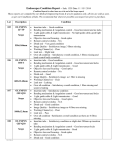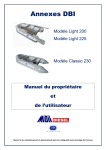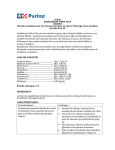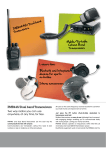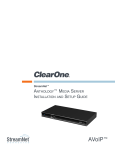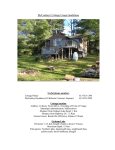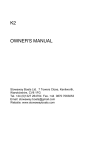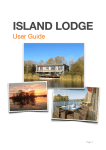Download Talamex inflatable boats – User`s manual
Transcript
Talamex inflatable boats – User’s manual TLM-GB201401 Page 1 of 17 Talamex® inflatable boats – user’s manual Page 1. 2. Page Contents Contents General 3.11.2 11 1.1 Introduction 3 3.11.2.1 Towing of an inflatable 1.2 Design category 3 1.3 Capacity plate 4 1.4 National legislation 4 4.0 Important safety information 12 1.5 General safety information 4 4.1 Pre-operating checklist 12 4.2 Stability and buoyancy 12 4.2.1 Position of persons and luggage 12 4.2.2 Rowing 13 4.2.3 Under engine power 13 4.3 Hazards 13 4. Specifications, description and features 2.1 Specifications 4 2.2 Boat model 4 2.3 Number of persons 4 2.3.1 Specifications 5 2.4 Payload 6 2.5 Outboard engine 6 2.6 Drawings 7 5. 3. Towing the boat 12 Safety and operation information Maintenance 5.0 General maintenance 14 5.1 Repairs 14 5.1.1 Small repairs 14 5.2 Winter storage 15 Assembly and disassembly 3.0 Floorboard 8 3.1 The valves 8 3.2 Rowing equipment 8 3.3 Seats and benches 8 3.4 Inflation of tubes 8 3.4.1 Order of inflation of tube 8 3.4.2 How to inflate 8 3.5 Floorboard installation 9 3.6 Inflatable floorboard 9 3.7 Rowing equipment 10 3.8 Engine installation 10 3.9 Deflation 11 3.10 Folding the boat 11 3.11 Transportation 11 3.11.1 Lifting the boat out of the water 11 7. Warranty conditions 16 8. Declaration of Conformity 17 Page 2 of 17 Talamex® inflatable boats – user’s manual 1. General 1.1 Introduction This manual has been compiled to help you to operate your Talamex® inflatable boat with safety and pleasure. It contains details of the Talamex® inflatable boat, the equipment, supplied or fitted, its systems, and information on its operation and maintenance. Please read it carefully, and familiarize yourself with the Talamex® inflatable boat, before using it. Ensure that the anticipated wind and sea conditions will correspond to the design category of the Talamex® inflatable boat and that you and your crew are able to handle the Talamex® inflatable boat in these conditions. Even when your boat is categorized for them, the sea and wind conditions corresponding to the design categories A, B and C range from severe storm conditions for category A, to strong conditions for the top of category C, open to the hazards of a freak wave or gust. These are therefore dangerous conditions, where only a competent, fit and trained crew using a well maintained craft can satisfactorily operate. This owner's manual is not a detailed maintenance or trouble-shooting guide. In the case of difficulty, refer to your Talamex® inflatable boat dealer. Always use trained and competent people for maintenance, fixing or modifications to your boat. Modifications that may affect the safety characteristics of the Talamex® inflatable boat, should be executed by competent people. The boat builder cannot be held responsible for modifications that he has not approved. In some countries, a driving licence or authorization are required, or specific regulations are in force. Always maintain your Talamex® inflatable boat properly and make allowance for the deterioration that will occur in time and as a result of heavy use or misuse of the Talamex® inflatable boat. Any Talamex® inflatable boat, no matter how strong it may be, can be severely damaged if not used properly. This is not compatible with safe boating. Always adjust the speed and direction of the Talamex® inflatable boat to sea conditions. The Talamex® inflatable boats should have onboard the appropriate safety equipment (lifejackets, fire extuingisher, etc.) This manual uses the following safety alerts to draw your attention to special safety instructions that should be followed. Warning WARNING - indicates a potentially hazardous situation that, if not avoided, could result in death or serious injury. Danger DANGER - indicates an imminently hazardous situation that, if not avoided, will result in death or serious injury. Caution CAUTION - indicates a potentially hazardous situation that, if not avoided, may result in minor or moderate injury or property damage. It may also be used to alert against unsafe practices. PLEASE KEEP THIS MANUAL IN A SECURE PLACE AND HAND IT OVER TO THE NEW OWNER WHEN YOU SELL YOUR TALAMEX® INFLATABLE BOAT. 1.2 Design Category Category C – “Inshore”. Craft designed for voyages in coastal waters, large bays, estuaries, lakes and rivers, where conditions up to and including wind force 6 and significant wave heights up to and including 2 m may be experienced. Category D – “Sheltered waters”. This craft is designed to operate in winds up to Beaufort force 4 and the associated wave heights (occasional maximum waves of 0,5 m height). Such conditions may be encountered in sheltered inland waters, and in coastal waters in fine weather. The boat you obtained is meant to be used in category C or D, depending on the model you are using. (see paragraph 2.3.1.) Page 3 of 17 Talamex® inflatable boats – user’s manual 1.3 Capacity Plate The manufacturer's CAPACITY plate is located on the inside of the boat transom. Never exceed the maximum values as mentioned on the plate. Never be under the influence of alcohol or drugs while boating (it is the law). Alcohol or drug use impairs your judgment and greatly reduces your ability to react quickly. Prepare other boat operators. Instruct at least one other person on board in the basics of starting and operating the outboard, and boat handling, in case the driver becomes disabled or falls overboard. Stop the engine whenever passengers are boarding, unloading, or are near the back (stern) of the boat. Just shifting the outboard into neutral is not sufficient. Be alert. The operator of the boat is responsible by law to maintain a proper lookout by sight and hearing. The operator must have an unobstructed view particularly to the front. No passengers, load, or fishing seats should block the operators view when operating the boat above idle speed. 1.4 National legislation Before you prepare for the water with your Talamex® inflatable boat, check the local legislation on any restrictions on the specific water you want to use. You might check for sailing restrictions, speed-restriction, restrictions on the use of outboard engines, restrictions on the airborne sounds, etc. 1.5 General safety information In order to safely enjoy the waterways, familiarize yourself with local and other governmental boating regulations and restrictions, and consider the following suggestions. Use flotation devices. Have an approved personal flotation device of suitable size for each person aboard (it is the law) and have it readily accessible. Do not overload your boat. Most boats are rated and certified for maximum load (weight) capacities (refer to your boat capacity plate). If in doubt, contact your dealer. Perform safety checks and required maintenance. Follow a regular schedule and ensure that all repairs are properly made. Know and obey all nautical rules and laws of the waterways. Never drive your boat directly behind a water skier in case the skier falls. Watch fallen skiers. When using your boat for water skiing or similar activities, always keep a fallen or down skier on the operator's side of the boat while returning to assist the skier. The operator should always have the down skier in sight and never back up to the skier or anyone in the water. 2. Specifications, description and features 2.1 Specifications Declaration of conformity: The Talamex® inflatable boats smaller than 2,50 metres, do not come under the aegis of the recreational Craft Directive 94/25/EC and therefore cannot be certified as complying with it. However, these models are built to meet all specifications required in the above-mentioned Directive as well as the ISO 6185 standards. 2.2 This is an inflatable boat that gets its form, strength and buoyancy by means of inflation with air. The boat is designed for small voyages in sheltered and open waters, depending on the design category (see 2.1). 2.3 Make sure everyone in the boat is properly seated. Do not allow anyone to sit or ride on any part of the boat that was not intended for such use. This includes any part of your boat, at which an unexpected acceleration, sudden stopping, unexpected loss of boat control, or sudden boat movement could cause a person to be thrown overboard or into the boat. Boat Model Number of persons Warning Do not exceed the maximum recommended number of persons. Regardless of the number of persons aboard, the total weight of persons and equipment must never exceed the maximum recommended load. Page 4 of 17 Talamex® inflatable boats – user’s manual Type Certificate number Max Load (kg) Max HP Max kW Max engine weight Max Persons Nr of Air Chambers Length (cm) Width (cm) Tube Diameter (cm) Weight including Oars (kg) Brochure weight D N/A N/A N/A 96x40x30 328 2,5 1,8 20 2 2 200 134 36 21 TLS 230 D N/A N/A N/A 96x50x30 415 4 2,9 25 2+1 2 230 134 36 23 TLA230 D N/A N/A N/A 96x50x30 372 5 3,7 30 2+1 2+1+1 230 134 36 25 TLA250 D 6185-1 II 44407-RCD-38513 100x50x30 400 6 4,4 30 2+1 3+1+1 250 149 42 28 TLA300 C 6185-2 V 44408-RCD-38514 105x55x40 425 10 7,4 45 4 3+1+1 300 153 42 37 TLA350 C 6185-3 VII 44409-RCD-38515 115x60x40 497 20 15,1 60 5 3+1+1 350 172 44 46 TLX250 D 6185-1 II 44407-RCD-38513 100x55x20 80x65x6 400 6 4,4 30 2+1 3+1 250 149 42 35 TLX300 C 6185-2 V 44408-RCD-38514 105x55x30 85x55x30 465 15 11,0 50 4 3+1 300 153 42 49 TLX350 C 6185-3 VII 44409-RCD-38515 115x60x30 115x60x30 696 20 15,1 60 6 3+1 350 172 44 59 TLR270 C 6185-2 V 44410-RCD-38516 240x120x47 480 10 7,4 45 3+1 3 270 162 42 65 HXL195 D N/A N/A N/A 105x60x30 372 3,5 2,6 20 2 2+1+1 195 143 42 21 HXL230 D N/A N/A N/A 105x60x30 448 3,5 2,6 20 3 3+1+1 230 145 42 24 HXL250 D 6185-1 II 44411-RCD-38517 105x60x30 400 4 2,9 25 3 3+1+1 250 145 42 26 HXL275 C 6185-1 II 44415-RCD-38522 105x60x30 600 6 4,4 40 4 3+1+1 275 145 42 28 HLA230 D N/A N/A N/A 105x60x30 460 5 3,7 35 3 3+1+1 230 143 42 29 HLA250 D 6185-1 II 44411-RCD-38517 105x60x30 490 6 4,4 40 3+1 3+1+1 250 143 42 32 HLA300 C 6185-2 V 44412-RCD-38518 116x65x35 700 15 11,0 50 5 3+1+1 300 170 45 40 HLA350 C 6185-3 VII 44413-RCD-38519 129x74x34 750 20 15,1 60 6 3+1+1 350 170 45 46 HLX250 D 6185-1 II 44411-RCD-38517 105x60x30 100x82x15 490 6 4,4 40 3+1 3+1 250 152 42 42 HLX300 C 6185-2 V 44412-RCD-38518 116x65x35 100x82x15 700 15 11,0 50 5 3+1 300 170 45 53 HTR350A C 6185-3 VII 44414-RCD-38520 129x74x34 725 20 15,1 60 6 3+2+2 350 170 45 53 HTR400A C 6185-3 VII 44415-RCD-38521 140x78x40 1100 30 22,1 90 8+1 3+2+2 400 200 50 72 HTR350X C 6185-3 VII 44414-RCD-38520 129x74x34 100x82x15 725 20 15,1 60 6 3+1+2 350 170 45 66 HTR400X C 6185-3 VII 44415-RCD-38521 140x78x40 120x90x150 1100 30 22,1 90 8+1 3+1+2 400 200 50 83 FLOOR BOARD ISO standard TLS 200 SKIN MODEL CE Design Category Bagged Dimensions (cm) 2.3.1 Specifications Page 5 of 17 Talamex® inflatable boats – user’s manual 2.4 Payload Warning When loading the Talamex® inflatable boat, never exceed the maximum recommended load. Always load the Talamex® inflatable boat carefully and distribute loads appropriately to maintain design trim (approximate level). Avoid placing heavy weight high up. 2.5 Outboard engine The maximum motor power of this boat is given in 2.3.1. in this manual. Danger Danger You might lose control of the boat when using the motor at full speed, accidents may occur. Talamex® - Talamex®Highline can not be held responsible for these actions. Warning Be cautious when refuelling, e.g., no smoking and direct treatment of fuel spillage in craft. Prevent the fuel lines from damaging when installing the engine. Avoid and prevent contact of flammable materials with hot engine parts. Overpowering a boat can result in serious injury, death or boat damage. Page 6 of 17 Talamex® inflatable boats – user’s manual 2.6 Drawings Page 7 of 17 Talamex® inflatable boats – user’s manual 3. Assembly and disassembly 3.0 Floorboard Talamex® Highline boats that are equipped with an inflatable or a non-inflatable floorboard must be operated with these floorboards properly installed before use. Using the boat without provided floorboard is unsafe, uncomfortable and it might result in damage to the boat. See point 3.5 and 3.6 for floorboard installation. 3.1 Valves The Talamex® - Talamex® Highline valves are especially designed for safe and comfortable use. The valves are designed flat to increase the comfort in the boat and to prevent damage to the boat. Operation of the valve: Take off outside cap. The valve is closed when the middle screw is in upside position. Push the valve once to open it. Push the valve again to close it. Pump connection: Put end piece (the part than must be turned) of the pump on the valve. Turn right (clockwise) and start pumping. Keep pumping until the right pressure is reached When ready, be sure to take off the pump. Be sure to put on the protection cap again.(for protection from dirt and damage). If the boat loses air pressure, first check the valves. Use a plant sprayer to spray a mix of water and soap on and around the valves. If you see air bubbles around the valves, please take the following steps: Take the valve key out of there is one in your repair kit. Put the valve key into the valve and turn the key clockwise and check for air bubbles again. If the valve still leaks, take back of valve in your hand and turn the valve stem with the key to the left (anti-clockwise) and take out the valve stem. Inspect the valve on damage. If there is any damage (see warranty conditions point 8), take the defective valve to your selling dealer. You will receive a new valve. Reinstall and lubricate valve stem with silicone or soapy water solution to ease installation. In case of persistent air leakage, contact your dealer and check warranty conditions. 3.2 Rowing equipment With the boat you have two oars or paddles. The oars can be taken apart for easy transport. The oars should be used in the rowlocks. 3.3 Seats and benches You must install the seat before fully inflating the boat. Inflate the boat for 75% and install the seat. When the seat is installed, the Talamex® inflatable boat can be fully inflated. 3.4 Inflation of tube The proper inflation and deflation is essential for a long life of your boat. To inflate the boat, roll out the boat on the floor. Remove any sharp objects from flat surface where boat will be assembled. If the boat is unpacked, check if all parts are present. Check if the valves are closed, by removing the safety cap from the valve. When the central button is positioned upwards, the valve is closed Get your delivered pump. Push the nozzle, end piece on the valve and turn right. The pump will tighten on the valve. Put enough air in the boat to give the boat some form. All chambers should be inflated equally to avoid damage to the bulkheads that separate the chambers. 3.4.1 Order of inflation of tube: Inflate the boat in the following order 1. front chamber (bow chamber) 2. side chambers 3. floor chamber (if applicable) 4. keel chamber (if applicable). Always Inflate the keel chamber last. 3.4.2 How to inflate Step 1: Inflate the chamber with the overpressure valve first, then Step 2: the remaining chamber(s). Put in enough pressure to allow the boat to spread out, but do not fully inflate the tube. Page 8 of 17 Talamex® inflatable boats – user’s manual Step 3: Pump the chamber with overpressure valve until it starts leaking air, Step 4: pump remaining chambers in right order until overpressure valve starts leaking again. If deflation is done in right order then the boat has the correct pressure and there is no distortion of fabric near the bulkheads. Never surpass these values! Inflate the boat to 0,25 bar = 3,6 PSI = 25 kPa Inflate the keel to 0.4 bar Inflate the high pressure bottom to 0,8 bar Inflate the keel approximately 5-10 strokes. The floorboards will be in a level position. Deflate the side-tubes of the boat completely and install the aluminum stringers When there are more than 3 floorboards, make a bridge between the second and third floorboard seen from the transom. Floorboards itself are numbered from the bow. Installation of the aluminum stringer After installation of the floorboards, put the stringers in the sides of the floor. Caution 4 3 Over-inflation can cause structural damage to your boat. Avoid the boat to stand in the direct sunlight when the boat is not in the water. This might heat up the air in the boat so much that expansion causes damage to your boat (!!!!except with properly used overpressure valve). 2 1 Do not use mechanical compressors to inflate your boat. The pump that is delivered gives exactly the right pressure to your boat. To install the stringers easier it is recommended to put an oar (paddle) under the bottom of the boat. This lifts up the floorboards to have easier access to put the stringers on the sides of the floor. 3.5 3.6 Floorboard installation Inflatable Floorboard Instructions to install the floorboards in the Talamex® models with a aluminum floor: Instructions for installing floorboards in Talamex models with an inflatable floor. If you fully inflate the air deck, it will push itself underneath the tube and it will stay there tight in its place. In the back of the boat there are two transom tracks fixed against the transom. To fix the floor at the transom, you have to slide the flaps that are attached at the back of the floor through the track Inflate the boat inclusive the keel section. (see the section on inflation). Check if no parts of the tubes keep sticking together. Deflate the keel, and deflate the boat for about 2/3. Place the front section (bow board 1) of the floorboard as far in the front of the boat as possible. Make sure the hole in the bottom is straight above the valve of the keel section. Place the side with the sticker faced down. Place part two into the boat. Put the two parts of the floorboard “in line”. Take part three and eventually part four of the floorboard. Push down the two parts to the bottom of the boat. Page 9 of 17 Talamex® inflatable boats – user’s manual Talamex® has two types of inflatable floors. Type 1: all models with inflatable floor, Air Speed models excepted. B A D 3.7 C 1. Put the flaps A at the after side of the floor in the transom track B. 2. Install the thrust board C at the forward most point of the port and starboard tubes. The thrust board must be placed under the air floor and on top of the keel D on the reinforced spot that you find on the inside in front of the tubes. 3. Place the deflated air floor D in the bottom of the inflated boat (DO NOT inflate the keel). Make sure the hole is exactly on top of the keel-valve. Inflate the inflatable floorboard to approximately 50% air pressure. Push the sides of the floorboard under the tubes as far as possible. 4. Inflate the air floor to minimum 700 mb, maximum 825 mb. Talamex® double action pump (e) is recommended for inflation of the air floor. DO NOT use a compressed air source unless it is outfitted with a pressure regulator set to 825 mb. 5. Inflate the keel. 6. Close the valves by putting the caps on top of it and turning them to the right. Type 2: Air speed models B Make sure the bottom/keel section is in the middle of the boat. Push the sides of the floorboard under the tubes as far as possible. 5. Fully inflate the whole boat (See section 3.4 for proper inflation of the total boat.) 6. Then fully inflate the integrated inflatable floorboard. C A Rowing equipment Talamex® Highline boats come standard or with paddles or with oars, oarlocks, and a seat. 3.8 Ensure seat is properly installed (see point 3.3). To install the oars in the oarlocks, you should keep up to this order: Point the blade to the bow and place the pin in the holder. Turn the oar a quarter turn, so that the blade points to the outside. The boat is now ready to row. If the oars are not in use, put the oars in the clips on the sides of the boat, with the blade pointing to the transom. Engine installation Outboard motor power. Danger Overpowering a boat can result in serious injury, death or boat damage. Using an outboard that exceeds the maximum horsepower limit of a boat can: 1) result in severe handling and/or stability problems 2) place too much weight at the transom altering the designed flotation characteristics of the boat 3) cause the boat to break apart particularly around the transom area. The maximum motor power to be used see 2.1 of this manual. 1. Put the foldable thrust board C in the back of the boat and push it towards the transom. 2. Put the flaps A at the after side of the floor in the transom track B. 3. Inflate the boat to approximately 25% air pressure. 4. Put the floor 25% inflated on the bottom of the boat. USE A LANYARD SWITCH. This switch will stop the engine if, for any reason, the operator leaves the control, see point 4. Page 10 of 17 Talamex® inflatable boats – user’s manual Mounting the engine: Make sure you are standing safely and stable. Unlock the motor for tilting and mount the motor on the transom. The motor must be in the middle of the transom for proper operation. Screw the brackets securely on the stern. Position of the outboard engine The outboard motor must be so installed that in the normal running position, it stands vertically in the water. This means that the “cavitation plate” on the low side or the outboard engine is horizontal in the water if the boat is lying in its normal position. All Talamex® boats are designed for using a short shaft motor The motor position is ssential for the right sailing features. Make sure the motor is trimmed properly, eventually use the spacers (not delivered with all models) to determine the right height of the motor. Push evenly on the whole boat to let as much air out as possible. If you deflate and store your Talamex® boat, you can leave the inflatable floor as it is installed, just leave out the air and fold the boat. 3.10 Folding the boat Lay the boat down on the floor. Take out the aluminium floorboards, if applicable. An inflatable floor can be left in place. Fold the boat to the middle of the boat, so that the whole boat is as wide as the transom. Bring the back of the side chambers to the middle. Roll the transom forward. This helps to get the air out. Be sure all valves are in the open position. Folded this way the boat fits in the delivered pack (sack) for transportation. A motor installed improperly, may cause spray water or cavitation (racing of the motor) Starting the engine 3.9 Pull the boat into the water. Secure the motor in the downwards position Stand securely and start the engine. Avoid very high speeds when running the boat backwards, water can come in the boat over the transom. Deflation General information: NOTE: Boat should be clean and dry before rolling up for storage. Remove any sand and debris that may cling to the fabric. When deflating the boat, do not deflate one chamber at once. Deflate all chambers evenly; this prevents damage to the bulkheads in the boat. Deflating the boat: Lay the boat down on the floor. Push the valve once to open it. Release some air from all chambers. Make sure the valve stays open ( to enable the air to get out during folding). If you prefer the oars to be in the same pack / sack as the boat take care that the oars will not damage the pack / sack. Put in the round parts of the oars first. 3.11 Transportation 3.11.1 Lifting the boat out of the water Make sure there are no sharp edges under the boat on the place where you want to lift the boat out of the water. Try to use the handgrips for lifting instead of the ropes. 3.11.2 Towing the boat If the boat is to be towed by another boat, the boat must be empty. Remove outboard, fuel tank and equipment. Warning - Never tow your craft with people aboard. - Frequently inspect the towing painter. - Periodically check the towing conditions and especially that the craft is not taking in water. Page 11 of 17 Talamex® inflatable boats – user’s manual 3.11.2.1 Towing of an inflatable IMPORTANT: The bow ring/grip handle should not be used for towing, anchoring, or mooring. Use the port and starboard points of the boat for towing. Towing this way makes the boat steady and secure behind the towing boat, and helps to avoid damage to your Talamex® boat. Attach a line between the towing rings to form a bridal. Attach a towing line to this bridle and tow the boat at slow speed. 4.0 Important Safety Information. Read this: The purpose of a lanyard stop switch is to stop the engine when the operator moves far enough away from the operator's position to activate the switch. This would occur if the operator accidentally falls overboard or moves within the boat a sufficient distance from the operator's position Warning Should the operator fall out of the boat, the possibility of serious injury or death from being run over by the boat can be greatly reduced by stopping the engine immediately. Always properly connect both ends of the stop switch lanyard to the stop switch and the operator. Check outboard for tightness on transom. Know the fuel capacity and cruising range. Check that the lanyard stop switch for the outboard works correctly. Be sure the boat is not overloaded. Do not exceed the maximum number of passengers or load capacity. Look at the boat capacity plate. Be sure there is an approved personal flotation device of suitable size for each person aboard and readily accessible. Check that the paddles are in the boat in case of engine trouble. Operator knows safe navigation, boating, and operating procedures. A ring type life buoy or buoyant cushion designed to be thrown to a person in the water. Arrange passengers and load in the boat so the weight is distributed evenly and everyone is seated in a proper seat or on the floor. Instruct at least one passenger in the basics of boat handling and the starting and operation of the outboard, in case the driver becomes disabled or falls overboard. Before departing, tell someone where you are going and when you expect to return. No alcohol or drugs. It is illegal to operate a boat while under the influence of alcohol or drugs. Know the waters and area you will be boating; tides, currents, sand bars, rocks, and other hazards. Warning Bilge water should be kept to a minimum; Warning Avoid serious injury or death from deceleration forces resulting from accidental or unintended stop switch activation. The boat operator should never leave the operator's station without first disconnecting the stop switch lanyard from the operator. 4.1 4.2 Stability and buoyancy 4.2.1 Position of persons and luggage For safe operation it is advised to have people sit in the middle of the boat as much as possible. Sitting on the sides of the boat is possible, if there is sitting someone opposite. Make sure you secure loose equipment safely when underway. Pre-Operating Check List Check the inflation pressure of the air chambers. Remove the plug from the self-bailer floor drain. Remove any obstruction from the self-bailer floor drain. Page 12 of 17 Talamex® inflatable boats – user’s manual 4.2.2 Distribution of load and weight take the bow down to a safe situation. Rowing Due to the position of the oars this Talamex® inflatable boat, you will have a comfortable rowing position. Use the delivered seat to make maximum use of the rowing possibilities. 4.2.3 Under engine power The bottom of your Talamex® Highline is designed to have a “V” shape (except from TLS boats). This improves the sailing characteristics, especially when operating an outboard engine. It is possible as well, to get the Talamex® Highline into “aqua-planing”. Caution While you are sailing on high speed or in “aquaplaning”: avoid abrupt corners and high waves, this might endanger the passengers. Make sure everybody holds on to the handles. For comfort and safety, reduce speed in waves. Small children must be sitting IN the boat. Breaking waves are a serious stability hazard. Always wear a lifejacket! SINGLE OPERATION. When operating under power without passengers, SIT NOT on inflation tubes or seat, weight should be as far forward and in the middle as practical. Avoid heavy weights near the transom. RAPID ACCELERATION should be avoided to prevent the possibility of backward flip-overs. Wind and wave conditions can be highly dangerous for your inflatable. You can easily be flipped over if the load in the boat is not distributed in the bow of the boat and wind and tide are against. Especially the Speed models should be driven carefully in headwind. The anti-cavitation plate on the engine should be about 20 mm under the bottom of the transom. If your outboard is too high on the transom, you will experience a lot of cavitation ( air bubbles and slippage around the propeller). If your outboard is too low on the transom it will create drag and it will throw up water into the boat. In both cases you end up with loss of speed, so try to find the ideal position, eventually using the delivered spacers, before you definitely bolt your engine to the transom (consult your supplier). At every used speed it is advised to keep the boat LEVEL. Prevent the bow to point UP, and prevent the bow from pointing DOWN towards the water. Use the weight of the people on board to achieve the level position. Adjust your engine angle (see below). An outboard tilted too far from the transom will drive the boat with a bow up attitude. An outboard tilted too close to the transom will drive the bow section too deep into the water, which ends up in loss of speed and/or cavitation. 1. Occasional checks should be made of motor attachment screws. Loose screws will cause erratic boat operation and possible loss of engine overboard. 2. Make at thorough review of the motor’s operator’s manual before operation. 3. On board loads should be monitored to avoid chaffing or puncturing of boat skin. Turning the boat When taking a sharp turn, reduce the speed of your boat. The boat will tilt considerably inside towards the turning centre. 4.3 Hazards Air chamber failure Your Talamex® boat is designed with more than one air chamber. Therefore, although in the event one of the air chamber might leak due to a puncture, the boat will at least save 50% of the buoyancy. Shift the weight to the opposite side. Secure the leaking chamber as necessary (by tyingup or holding-up) and immediately proceed to the nearest shore or mother ship, which is nearest. Page 13 of 17 Talamex® inflatable boats – user’s manual However, be careful about shallows or reefs, because they can scratch or further damage your boat. Beaching It is recommended that the boat NOT be powered onto the beach, dragged across rocks, sand, gravel or pavement as damage to the boat skin may result. Davits If the boat is suspended on davits, remove the drainplug so that no water can accumulate in the boat. Drain plug (Rib Models) The Rib is equipped with a hull/cavity drain plug. Both must be installed when launching the boat. The hull cavity plug should be removed periodically to eliminate water from condensation in the inner hull. The deck drain plug should be removed only when the boat is under power in forward motion or when the boat is stored out of the water on davits or boat storage racks exposed to rain and water. Sunlight Avoid the boat to be exposed to sunshine for a longer period. The changing air pressure inside the tubes might cause damage to your boat. Extreme sunshine (ultra-violet rays) over a longer period may accelerate ageing of the materials, which may cause a sticky surface. Cover the boat to block direct sunlight exposure if the boat is to be removed from the water for an extended periods of time. Smoking Refrain from smoking especially while refueling your boat. Portable fuel tanks should be placed on a cushioning base and should be strongly secured to the craft by means of a girth to avoid bumps and risks of breaking during navigation. - When refueling, always stick to the following recommendations: - If possible, remove portable tanks from the craft to refuel. - Refuel the tanks in the open air, far from heat sources, sparks or flames. - Do not fill the tanks to the brim. The fuel increases volume with a rise in temperature and there is a possibility of the tank overflowing or even breaking. High altitude use Normal full inflation pressure–is 330 mbar. If boat is inflated at sea level (low altitude) and transported to a high altitude (i.e., for use in a mountain lake) the air pressure must be reduced at the higher altitude to prevent over inflation. 5. Maintenance 5.0 General maintenance Cleaners. Cleaners special for inflatable boats, should be used only and not discharged into waterways. Never mix cleaners and be sure to use plenty of ventilation in enclosed area. DO NOT use strong detergents, solvents or products, which contain phosphates, chlorine, solvents, non-biodegradable or petroleum based products. Cleaning your Talamex® Boat can best be done using special cleaner for inflatable boats.. IMPORTANT: Waxes or cleaners containing alcohol or hydrocarbons SHOULD NOT BE USED on the boat fabric. These products will prematurely dry out or damage the boat fabric. 5.1 Repairs 5.1.1 Small repairs If you have any damage to your Talamex® inflatable boat, it is strongly advised to go to your Talamex® Boat dealer for the reparation. If the damage is a small puncture you can use the material you find in the repair kit. Larger areas or if patch will overlap a seam should be patched by a professional repair technician at an inflatable repair station. Contact your local Talamex® Higline dealer for the nearest inflatable repair station. For the best results when gluing, the relative humidity should be less than 60%, ambient air temperature should be between 18 °C to 25 °C (65 °F to 77 °F) and not in direct sunlight. In general, work as follows: Cut out a patch large enough to overlap the damaged area by 30 mm from all sides. Centre the overlapping patch over the damaged area and trace with a pencil the outline of the patch. Clean the surroundings of the puncture and the patch. Apply two thin layers of adhesive using a short bristle brush, in a circular pattern on both the backside of the patch and the patch area on the boat. Allow the first layer to dry completely (approximately 15 minutes) before applying Page 14 of 17 Talamex® inflatable boats – user’s manual the second layer. The second layer should dry until tacky, then apply the patch to the prepared area and press down firmly. Using a smooth object (the back of a tablespoon works well), force out any air bubbles that may have been trapped under the patch, working from the centre of the patch to the outside. Wait 24 hours before you inflate the boat again. Consult your local dealer when experiencing problems. 5.2 (Winter) Storage IMPORTANT: To prevent hull or tube discoloration from marine growth or polluted waters, DO NOT store boat in the water for extended periods of time. 1. After use, the boat and all components should be washed and rinsed with fresh water. Dry all parts before storage in the carrying bag. This will help prevent mould or mildew. 2.The transom should be inspected for damage or deterioration of the finish. Scratches or abrasions should be refinished with a marine grade varnish. 3. To keep the boat looking new, store the boat in a cool dry area and avoid excess exposure to direct sun light. 4. An accessory cover is available to cover and protect your boat during storage. 5. If you store your boat for a longer period do not keep the boat in the delivered pack (or sack). The boat is folded too tight in the pack, which gives sharp folds in the material. Role or fold up the boat loosely and store it on a dry place.To avoid damaging the boat during storage, do not place heavy objects on the boat. If the Talamex® inflatable boat is stored for a longer period at a temperature below 0ºC, it needs to be sored at a temperature of at least 20ºC for at least 24 hours, BEFORE the Talamex® inflatable boat is released. Page 15 of 17 Talamex® inflatable boats – user’s manual 7. Warranty LIMITED WARRANTY I. We guarantee each new production Talamex® inflatable boat and accessories attached thereto (hereafter referred to as “Product”) to be free from defects in material and workmanship, but only when the consumer sale is made in a country to which distribution is authorized by us. II. The warranty shall become effective only upon receipt of a completed Warranty Registration Card or digital registration confirmation, which should happen 2 weeks after purchase at last. The product will be registered by a serial number This warranty shall remain in effect as described below. A. For Talamex® Highline boats, a 3-year warranty of the hull fabric against cracking, porosity and rot, is valid. The material of all the other Talamex® boats are covered by a 2-year warranty against cracking, porosity and rot. B. Fibreglass hull is covered by a 2-year warranty. C. Hull seams of Talamex® Highline boats are covered against delaminating by a limited 3-year warranty, where hull seams of all other Talamex® boats are covered against delaminating by a limited 2-year warranty. NOTE: Seams are determined to have delaminated when the outer coating separates from the fabric base or the seam loses its structural strength. If delamination occurs on only one seam and not on the entire boat, the seam is to be repaired under warranty. D. All other boat parts, including but not limited to components such as car locks, lifting handles, pumps, boat bag transom holder, transom, “D” rings, stringers, “H” fittings, floor boards are covered by a limited 2 year warranty. III. Exclusion of this warranty Since this warranty applies only to defects in material and workmanship, it does not apply to normal wear and tear, or to damage caused by: A. Neglect, lack of maintenance, accident, abnormal operation or improper installation or services; B. Use of an accessory or part not manufactured or sold by us; C. Participating in or preparing for racing or other competitive activity; D. Alteration or removal of parts. E. Use of an outboard motor with a higher capacity than the capacity plate indicates. F. Charter, rental and commercial use. G. Damage as a result of force majeure including, but not limited to abnormal water, wind and weather circumstances, etc. H. Incorrect use like, but not limited to, incorrect harbouring, beaching or towing, collision, incorrect use of a trailer. I. Damage as a result of theft or fire. J. Damage caused by rainfall from the sky, tree juices, spilling of chemicals K. Normal abatement, wear, discolouration, dullness and aging of cloth, metal, wood and plastic. L. Damage or abatement of cosmetic surfaces like tears, hair cracks, discolouration, hallowed spaces, fading or oxidation of the gel coat. M. Osmotic blistering or tears in the gel coat, including spider shaped tears. N. Costs of normal maintenance and cleaning O. Consequential damage or incidental damage. P. Moisture damage to wooden parts as a consequence of not maintaining a protective coating for these parts. Q. Damage caused by use of cleaners, other than advised elsewhere in this manual. IV. This warranty does not cover incidental or consequential costs or expenses such as: haul–out, launch, towing transport and storage charges; telephone or rental charges of any type, inconvenience, or loss of time or income; or other consequential damages. V. Customer must provide reasonable access to the product for warranty service by delivering the product for inspection to a Talamex® dealer authorized to service the purchaser’s product. Purchaser shall pay for all related transportation charges and/or any other expenses associated with that service. Any product or parts shipped by purchaser for inspection or repair must be shipped with transportation charges prepaid. The Warranty Registration Card, in combination with the purchasing account, is the only valid registration identification and must be presented at the time warranty service is required. Warranty claims will not be accepted without presentation of the Warranty Registration Card. VI. Our obligation under this Warranty shall be limited to repairing a defective part, or at our option, refunding the purchase price or replacing such part or parts as shall be necessary to remedy any malfunction resulting from defects in material or workmanship as covered by this Warranty. We reserve the right to improve the design of any product without assuming any obligation to modify any product previously manufactured. VII. This warranty gives you specific legal rights, and you may also have other legal rights that vary from country to country. Page 16 of 17 Talamex® inflatable boats – user’s manual Page 17 of 17


















